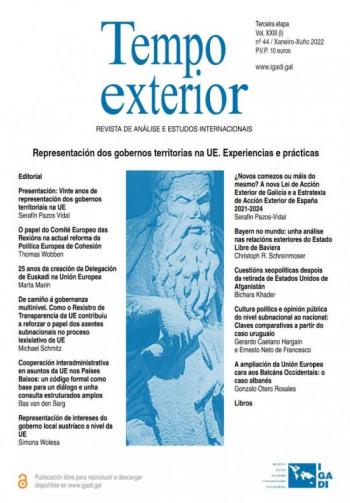In this monographic issue of Tempo Exterior several EU practitioners with more than 20 years of experience in the representation of territorial interests towards and in the European institutions and the community decision-making process provide their personal perspective on their practice. Although there has been extensive academic literature on so-called territorial mobilization since the 1980s (e.g. Tatham & Thau, 2014; Marks, Haesly & Mbaye, 2010), the testimonies of the actors themselves involved in this type of representation and intermediation of interests have been less common in academic journals.
We would like to thank Tempo Exterior and IGADI for the opportunity to publish this monographic issue.
In May 2022 the work of the Conference for the Future of Europe was completed, which took the wake of the 2001-2003 Convention on the Future of Europe, which after a tortuous process of two negative referendums in France and the Netherlands took place for almost a decade. then to the current Lisbon Treaty. Several of the authors of this special issue took part as advisers to the politicians who participated in that process.
One of the most sensitive aspects of that Convention was the treatment of the territorial question and the principle of subsidiarity, which produced what we know today as Article 5(3) of the Treaty on European Union on the principle of subsidiarity, the EU’s duty to protect local self-government and regional cohesion as well as the need to involve territorial legislators in overseeing the principle of subsidiarity, via state legislatures but also by the Committee of the Regions (CoR), an advisory body which had already been introduced by the Maastricht Treaty 1992 and launched in 1994. Maastricht also allowed the so-called regional ministers to represent their Member State in the formations of the EU Council in accordance with their competences.
We now have a broad enough perspective to assess the expectations and realities of territorial representation in the EU. Certainly, these are not the times when the paradigm of “Europe of the Regions” had a certain prevalence as a kind of evocation of an EU as a post- national legal-political entity governed by the paradigm of multilevel governance, which, regardless of its multiple conceptions (Stephenson, 2013 ), basically seeks to articulate in the most coordinated and consensual way possible – what has been known since 2018 as “active subsidiarity” – the solution to problems shared by the sub-central, state and community levels (Moodie, Salenius, & Meijer, 2022; Pazos-Vidal , 2019a).
While the EU has greatly expanded its scope, the same cannot be said of the EU’s territorial dimension. The Great Recession of 2008 led to a major expansion of EU-wide supervisory capacity of what were previously conceived as domestic public policies in areas such as pensions or utilities: the so-called Fiscal Treaties and the expansion of the so-called European Semester.
The crisis of COVID-19 has led to the expansion of the EU’s previously residual competences in health, as well as the transfer of the Rubicon which means starting to finance the European budget ( NextGenerationEU, with 750 billion Euros the largest investment fund in the EU in history, doubling the Regional Policy and the Common Agricultural Policy) through the joint issuance of European public debt ( Bachtler, Mendez, & Wishlade, 2020).
The so-called rule of law backsliding crisis is leading to a strengthening of the capacity of the EU institutions to penalize those Member States (and consequently their territorial entities) that are violating the principles of the Treaties (cf. .Bárd & Grabowska-Moro, 2020) , in a rather activist perspective. This activism and expansion of the scope of interpretation of the Treaties is also present in the EU Court Justice and which continues to be questioned not only by certain governments but also by constitutional courts such as the German one (Pazos- Vidal, 2020).
However, despite this expansion of the scope of European decisions to the domestic sphere of Member States (or rather they having greater visibility, as the weight of EU legislation and Commission oversight greatly has long weighted into the provision of public services and even their organization by way of EU legislation on public procurement, state aid or the environmental) does not correspond to a greater presence of sub-state institutions in European decision-making processes. Tellingly, the conclusions of the Conference, simply note the importance of the territorial dimension (Conference on the Future of Europe, 2022: 84).
So what happened? Several things… You can dowland the complete Presentation ou the Tempo Exterior 44 here (look up, in the right corner of the wbsite, you can access the texts in English)


